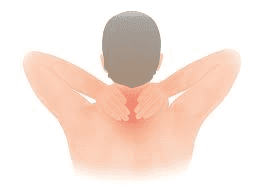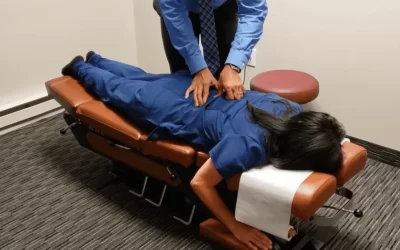
Hello, everybody. Welcome back. This video is a little different than all the other videos. I have these buddies Frank and David. Hi, Frank & David! They’re the reason we’re doing a video.
They asked me to show them some of these adjustments that I do on patients. We were discussing how some people are stuck in fight or flight. Their nervous system is more sympathetic and not so much parasympathetic. We know from physiology, we know that all healing repair and regeneration happens during rest and the body has to be in parasympathetic, which is the opposite of fight or flight.
So are there adjustments that will bring a body out of fight or flight if they’re stuck in it? We know certain alignments in the spine do increase the fight or flight response, and others can reduce it.
The Thoracic Spine Adjustment (Upper Back)
We’ll start with this one. One is the upper back- the Thoracic Spine. Whenever there is a flattening of the thoracic spine, that person has a higher tendency to be stressed.
Katie is a nurse, and she oversees all patient care in our office. She had this adjustment multiple times, and she has volunteered. So turn sideways, this way. I want you to notice, see out of this area. When I push her shirt in, there needs to be a curve here. So whenever this is reduced, and it’s flat, those nerves there go to the heart and the lungs. What we want to do is create a curve. We want to adjust in a way that improves that curve.
So lie on your back, bend the knees. Interlock your fingers behind your neck and elbows up. What I’m going to do is use the arms as leverage to lift and curl. Can you see how this curves that upper back? We’re going to adjust in that curved motion. Take a deep breath, breathe out, and fall back, and that already popped! One more, a little lower, there’s the other one. So that’s all.
I know most chiropractors know the one where you cross the arms and do an anterior adjustment, which is great. This is the best way to really increase that curve.
Cervical Vertebrae Adjustment
So another one is when the cervical vertebrae are more forward, more anterior. That tends to increase the fight or flight syndrome. Sometimes when we’re adjusting and keep pushing back to front, we end up intensifying that.
So imagine if there’s a vertebra. Let’s say this is a bone like this. That’s the front, and this is the back. So imagine this is my neck bone. If it is rotated this way, you can either contact this side and rotate it from back to front, or you can go anterior from this side. A lot of times, when someone’s stuck in fight or flight, the anterior version works better.
I’m going to show you how that looks. We’re going to actually palpate and see if there’s a spot that is tender. The scalene muscles are going to be tight and tense on the side of the anteriority. So we’re going to look right here. It is actually pretty tender when I pressed that. Do you feel that? Not as bad on this side, more on this side.
We are going to adjust anterior right here. This is probably C4 we’re contacting. With my thumb, I’m going to find the area that is tender. I don’t want to go right on the bone. I want to have some tissue separating my thumb from the bone; otherwise, it’d be too rough of a contact. So, Katie, that’s not too uncomfortable. It is very tender, though. I’m going to hold here and bring her head this way and up. Does that make sense? My thrust is going to be A to P and right to left. It’s a rotation to the right. So this hand is supporting and bringing the head and the thrust is with this hand, my right hand. And so I’m going to go ahead and thrust right now. It’s kind of a pull in this direction.
Katie, did you feel the adjustment? Did you feel it on this side of your neck? It was right under my thumb, going down and back. It’s almost like that J hook motion where you just pull back. You don’t need force and you don’t even need a lot of speed. When it’s locked up and it’s stuck in that anterior motion, it wants to go.
This is one of those adjustments where you get instant relief. The scalenes will relax. You can press on it, and they won’t be tender anymore. All right, so she is now completely out of fight or flight. Remember, this is all based on doing the HRV. We are able to measure whether someone’s body is chronically stuck in fight or flight, or if they’re exhausted, or if they’re just suppressed from their ability to handle stress.
The last part, we always want to check if someone is stuck in fight or flight, is the alignment of the sacrum.
The Sacral Adjustment (Lower Back)
Sacrum can nutate and counter nutate. Of course, they can side bend and so on. So whatever analysis you use, use that. Whether it’s an x-ray or not. Typically we use x-ray. We draw lines and make the measurements.
One thing I know is that forward tilting of the base of the sacrum, which is nutation tends to be more parasympathetic, and counternutation tends to increase the sympathetics. This is just a theory based on my personal experience, you know, practicing for 20 years.
I also know that exhale and inhale are affected by mutation connotations. When you breathe in, there’s a little bit of a counter-nutation, and when you exhale, there is nutation. When you look at physiology, when you’re stressed, you tend to inhale hard and hold your breath. So something scary happens. That’s the scared response. But, when you know everything is fine, you go with a sigh of relief. That’s parasympathetic.
We want the body to be easily able to exhale. It makes sense to nutate the sacrum. So a simple contact and adjustment would be you press here and push forward using the drop table. So you can prop it up.
I don’t want to really do it on Katie today because that is not one she needs. It would be very simple and gentle. Contact the base of the sacrum and push into that rotation. If this was tighter, I would actually be thrusting and putting that in. If you wanted to do a counternutation, it would be in this motion and drop down that way.
Hopefully, that helps you. There’s a thoracic, there’s a cervical, and there’s a sacral adjustment that can help. Obviously, they all have to be based on listings. Do not adjust it just to get the patient out of fight or flight. It has to be a subluxation there to do the adjustment. But if the subluxation, you have a choice of adjusting from front to back or back to front. If the patient is in sympathetic overdrive or stress overload, you want to always do front to back. You want to do flexion on the thoracics and nutation on the sacrum.
I hope you enjoyed it. Send me some notes, comments, whatever. Frank and David, that was for you. Take care, talk to you later. Bye, everyone.






